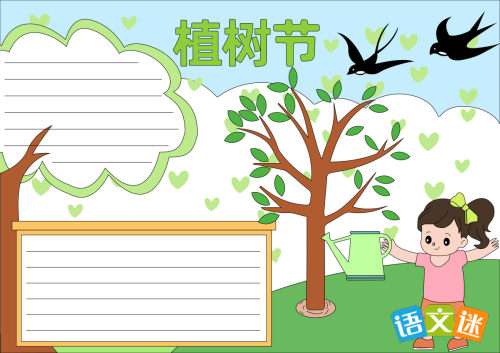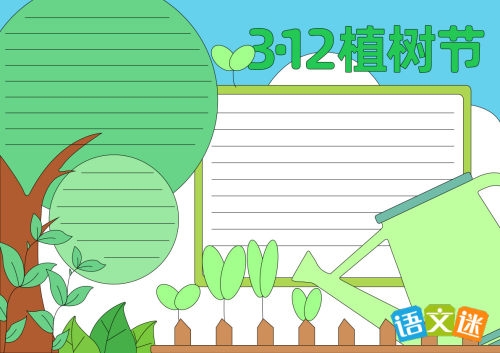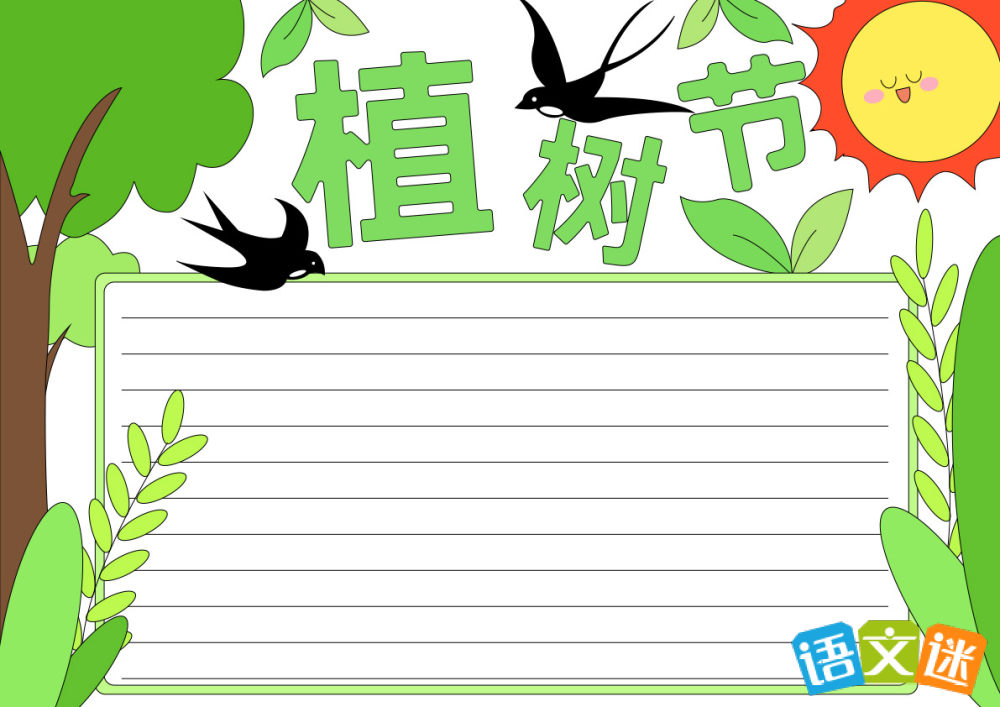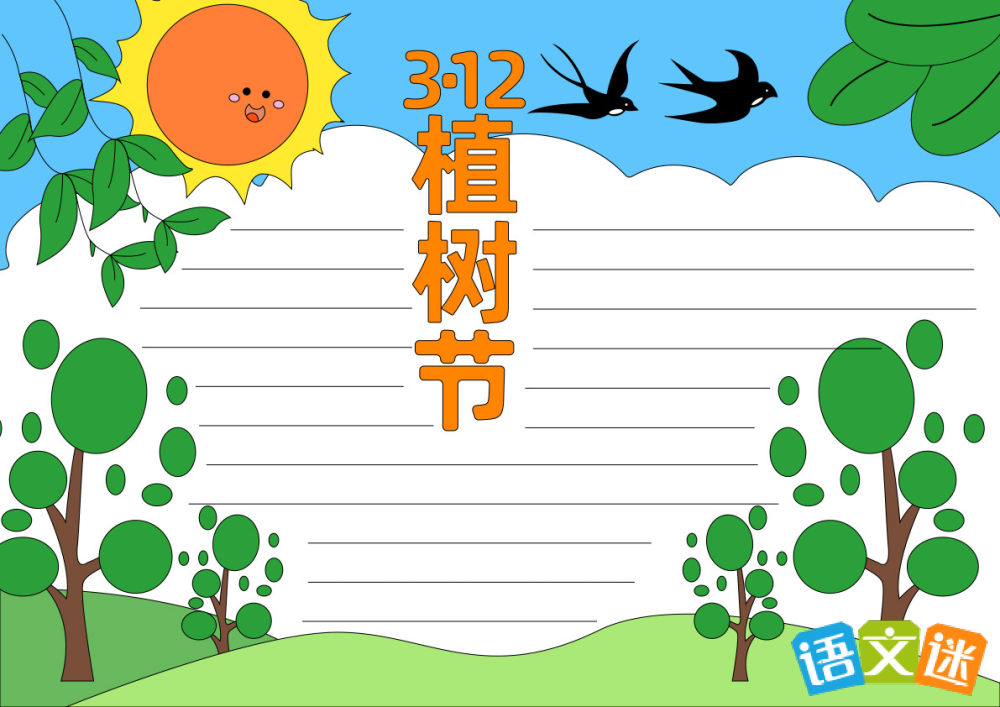- 植树节英文手抄报内容 推荐度:
- 相关推荐
植树节英文手抄报内容
在各个领域,许多人都接触过一些比较经典的手抄报吧,手抄报具有相当强的可塑性和自由性。那什么样的手抄报才是好的手抄报呢?下面是小编为大家整理的植树节英文手抄报内容,希望能够帮助到大家。
植树节英文手抄报内容





节日的起源
In ancient China, there was a tradition of planting willows and trees during the Qingming Festival. The earliest practice of planting trees on the roadside in history was initiated by a person named Wei Xiaokuan from Shaanxi over 1400 years ago. Wei Xiaokuan (508-580 AD) was a famous general during the Western Wei and Northern Zhou dynasties, born in Jingzhao Duling (now southeast of Xian). According to the 52nd biography of Li Yanshou in the Northern History of Tang Dynasty, in the second year of Emperor Fei of Western Wei (552 AD), Wei Xiaokuan was awarded the title of Governor of Yongzhou for his military achievements. Since ancient times, a earthen platform has been set up every one li on official roads as a marker to calculate the mileage of the road, which is now a milestone. After Wei Xiaokuan took office, he found that the earthen platform had many shortcomings. It was prone to collapse due to wind, sun, and rain, and needed frequent maintenance. This not only increased the countrys expenses, but also caused the people to suffer from labor, which was both time-consuming, laborious, and inconvenient. After investigation and understanding, Wei Xiaokuan resolutely ordered that all places where soil platforms were set up on official roads in Yongzhou be replaced with a locust tree. In this way, not only does it not lose its marking and odometry function, but it can also provide shelter from wind and rain for pedestrians, without the need for repair. Wei Xiaokuans approach is undoubtedly a major measure to benefit the mulberry land, reduce the burden on the local people, and benefit the country and the people. Shaanxi, as the earliest place in history to plant trees on official roads, was once a model for road greening in the country. Wei Xiaokuans earliest planted locust tree has been loved by people for thousands of years, especially the people in western Shaanxi who have a special fondness for this type of locust tree, and it is widely planted. Now, this type of locust tree has become a symbol of Xian and has been designated as a city tree.
The Arbor Day in China has been revised three times due to the evolution of the times. In the fourth year of the Republic of China (1915), at the initiative of Sun Yat sen, Zhou Ziqi, the Minister of Agriculture and Commerce, presented to the President of the Peoples Republic of China the annual Qingming Festival as the Arbor Day. He designated a location, selected tree species, and all levels of government, government agencies, and schools across the country attended as scheduled to hold Arbor Day ceremonies and engage in tree planting. After approval on July 21, 1915, the entire country was ordered to follow and handle as scheduled. On April 7, 1928, the Nationalist government issued an order to the whole country: "Afterwards, the Qingming Tree Planting Day in the old calendar should be changed to a commemorative tree planting ceremony for the death of the Premier." On February 9, 1929, the Ministry of Agriculture and Mining issued a ministerial order to announce 16 articles of the "Interim Regulations on Tree Planting in Provinces for the Remembrance of the Death of the Premier.". In February of the 19th year of the Republic of China (1930), it was submitted to the Executive Yuan and the National Government as the "afforestation campaign propaganda week" from March 9th to 15th, and a tree planting ceremony was held on the anniversary of the death of Mr. Sun Yat sen on the 12th.
After the establishment of the Peoples Republic of China, in February 1979, at the sixth meeting of the Standing Committee of the Fifth National Peoples Congress, Luo Yuchuan, Director of the State Forestry Administration, proposed to review the Forest Law (Trial Draft) and explained the decision to designate March 12th as Chinas Arbor Day. After that, the congress passed it. On December 13, 1981, the Fourth Session of the Fifth National Peoples Congress discussed and passed the Resolution on Launching the National Compulsory Tree Planting Movement. From then on, the nationwide voluntary tree planting movement began to be implemented as a law throughout the country. The following year, the State Council issued the Implementation Measures for Carrying out the National Compulsory Tree Planting Movement.
China has a vast territory and significant climate differences, and the suitable time for planting trees varies in different regions. Therefore, many provinces and cities also set their own planting days, planting weeks, and planting months.
Modern Arbor Day was first initiated by Nebraska, USA. Before the 19th century, Nebraska was a barren plain with sparse trees and yellow sand, causing great suffering for its people. In 1872, the famous American agronomist Julius Sterling Morton proposed to establish Arbor Day in Nebraska and mobilize the people to plant trees in a planned manner. At that time, the state agriculture bureau adopted this proposal through a resolution, and the governor personally designated the third Wednesday of April as Arbor Day. In the following 16 years, 600 million trees were planted successively, finally turning 100000 hectares of wilderness in Nebraska into dense forests. In recognition of Mortons achievements, the 1885 state legislature officially designated Mr. Mortons birthday on April 22nd as Arbor Day each year, with one day off. Later, after discussion, the worlds first Arbor Day stamp was issued in 1932, featuring two children planting trees.
In the United States, Arbor Day is a state holiday without a nationally designated date. But every April and May, every state in the United States organizes Arbor Day activities. For example, Rhode Island stipulates that the second Friday of May each year is Arbor Day, with one day off. Some other states have fixed dates, while others have Arbor Day dates temporarily decided by the governor or other government departments each year. Whenever Arbor Day arrives, a vast army of people from all walks of life, mainly students, form a strong army to participate in tree planting activities.
According to statistics, one-third of the United States is covered by forest trees, and this achievement is inseparable from tree nodes.
法律规定
On December 13, 1981, the Resolution on Launching the National Compulsory Tree Planting Movement was passed.
In 1982, the State Council issued the Implementation Measures for Carrying out the National Compulsory Tree Planting Movement.
Starting from July 1, 2020, the newly revised Forest Law of the Peoples Republic of China will be implemented, specifying March 12th as Arbor Day each year.
The new Forest Law implements forest classification management, dividing forests into public welfare forests and commercial forests. Public welfare forests are strictly protected, while commercial forests are operated independently by forestry operators in accordance with the law, in order to protect the legitimate rights and interests of various forestry operators and achieve sustainable development of forestry construction.
In addition, the new Forest Law has adjusted the scope of issuance of forest logging permits, and no longer applies for logging permits for bamboo forests outside of nature reserves. The logging of farmland protection forests, wind and sand fixation forests, road protection forests, bank and embankment protection forests, and urban trees on non forest land shall be managed in accordance with the provisions of the Highway Law, Flood Control Law, and Urban Greening Regulations.
节日效果
The worlds largest, most participated, and most effective voluntary tree planting movement has been ongoing in China for more than 30 years. For many years, the Party and state leaders have conscientiously fulfilled the obligation of citizens to plant trees, no matter how busy their work is, whether in Beijing or other places. Statistics show that since the launch of the National Compulsory Tree Planting Movement in 1982, more than 10.4 billion people in China have participated in voluntary tree planting, with a total of over 49.2 billion trees planted voluntarily.
The nationwide voluntary tree planting movement has effectively promoted the improvement of Chinas ecological conditions. Before the launch of this movement in 1981, China had a forest area of 1.729 billion acres, a standing timber volume of 10.26 billion cubic meters, and a forest coverage rate of 12%. After years of unremitting struggle, Chinas forest area has reached 2.62 billion acres, the volume of standing trees has reached 13.618 billion cubic meters, and the forest coverage rate has increased to 18.21%. In the context of the decreasing world forest resources, China has achieved sustained growth in forest resources. The improvement of forest vegetation not only beautifies the home, reduces the harm of soil erosion and sandstorms to farmland, but also effectively enhances the carbon storage capacity of the forest ecosystem.
On the occasion of the 35th Arbor Day and the first International Forest Day, the Office of the National Greening Committee released the 2012 China National Land Greening Status Bulletin today (11th). The communique stated that the per capita forest area and per capita park green space area in China are still relatively small, and the development of regional and urban-rural afforestation and greening is still unbalanced. The task of consolidating the achievements of national greening is arduous.
Zhao Shucong, Deputy Director of the National Greening Committee and Director of the State Forestry Administration, said here, "Green is fundamental to a beautiful China. Without forests and wetlands, how can we talk about the beauty of mountains and rivers?" According to the "Communique", in 2012, a total of 600 million people in China participated in various forms of voluntary tree planting activities, planting 2.6 billion trees. As of the end of 2012, the total number of people participating in voluntary tree planting in China reached 13.9 billion, with 64 billion trees planted voluntarily.
According to statistics from the State Forestry Administration, China afforestation reached 6.01 million hectares in 2012, of which 2.74 million hectares were key forestry projects, accounting for 45.6%. As of now, the green coverage area of urban built-up areas in China is 1.719 million hectares, an increase of 107000 hectares compared to the previous year; The per capita park green space area in the city is 11.8 square meters, an increase of 0.6 square meters compared to the previous year. The green coverage rate and green space rate of urban built-up areas in China have reached 39.2% and 35.3%, respectively.
According to the 2020 China National Land Greening Status Bulletin released by the Office of the National Greening Commission, China completed 6.77 million hectares of afforestation, 8.37 million hectares of forest nurturing, 2.83 million hectares of grassland improvement through grass planting, and 2.096 million hectares of sand prevention and control in 2020.
生态价值
The establishment of Arbor Day is to advocate for people to plant trees, encourage people to love trees, and remind people to pay attention to trees. Trees play a very important role in human survival and the ecological environment of the Earth.
The fundamental purpose of establishing China Arbor Day in China is to protect forests and increase tree planting. The growth of every big tree has a significant positive impact on human society.
Professor Des from Kolkata Agricultural University in India calculated the ecological value of a tree:
A 50 year old tree, calculated cumulatively, produces oxygen worth approximately 31200 US dollars;
The value of absorbing harmful gases and preventing air pollution is approximately 62500 US dollars;
Increasing soil fertility value by approximately 31200 US dollars;
The value of conserving water sources is $37500;
Providing breeding grounds for birds and other animals worth $31250;
The protein value generated is $2500, with a total value of approximately $196000.
【植树节英文手抄报内容】相关文章:
植树节英文手抄报内容(通用5篇)09-21
环保手抄报英文内容08-18
植树节手抄报内容精选09-25
植树节的内容手抄报08-31
植树节手抄报内容07-12
植树节手抄报的内容09-22
植树节手抄报内容02-29
植树节的手抄报的内容08-30
植树节的手抄报内容10-02
春天来了手抄报英文内容04-27
